- 9. Psammisia KLOTZSCH Linnaea 24: 42 (1851). -- Lectotype: Psammisia falcata
- (H.B.K.) KLOTZSCH.
Reference: LUTEYN, J. L., New species and notes on neotropical Ericaceae, Opera Bot.
92: 109--130 (1987).
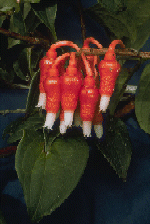
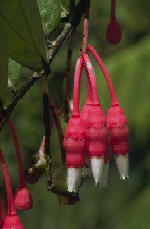
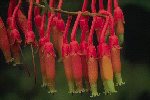
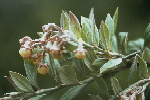
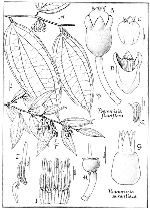
Epiphytic or terrestrial shrubs. Leaves alternate, coriaceous, pinnate or plinerved,
petiolate. Inflorescence axillary or terminal, subfasciculate or racemose with few
to many flowers; pedicel bibracteolate. Flowers 5-merous, without odor; aestivation valvate; calyx articulate with the pedicel; hypanthium short-cylindric or campanulate;
limb erect or spreading; lobes (2--4-) 5, ovate or triangular, apiculate or acute;
corolla carnose, subcylindric, elongate urceolate or subglobose, the lobes triangular and subacute; stamen (8-) 10 (-12), equal, from about 1/3 to often nearly
as long as the corolla; filaments equal, distinct or connate, the connectivess all
or alternately 2-spurred (rarely spurs obscure or lacking), the spurs either acute
and conspicuous or rounded and not very apparent; anthers equal, inserted dorsally near
the base, stout, lacking disintegration tissue; thecae strongly granular; tubules
distinct, 1/4 to about as long as the thecae, dehiscing by elongate introrse clefts;
pollen lacking viscin threads; ovary inferior, 5-locular; style filiform and often
exserted. Fruit a berry.
Psammisia
consists of approximately 70 species ranging from Costa Rica southward into Bolivia
and eastward to French Guiana and Trinidad.
Key to Species of Psammisia
- 1a.
- Corolla subglobose, broadly urceolate, or cylindric-urceolate to cylindric-subglobose,
up to 14 mm long.
- 2a.
- Leaves plinerved.
- 3a.
- Inflorescence with a conspicuous peduncle 2.5--6 cm long
- ..............................................................................P. dolichopoda
- 3b.
- Inflorescence without a peduncle.
- 4a.
- Leaves 10--30 cm long, the apex acuminate or cuspidate.
- 5a.
- Leaves 13--25 cm long; rachis 0.4--2.2 cm long; calyx 8--11 mm long; corolla
bright butter-yellow; staminal filaments distinct
- ............................................................P. flaviflora
- 5b.
- Leaves 10--15 cm long; rachis 2--4 cm long; calyx 6--7 mm long; corolla coral-red;
staminal filaments connate.
- ............................................................P. corallina
- 4b.
- Leaves 2--10 cm long, the apex rounded to bluntly acute.
- 6a.
- Inflorescence subfasciculate, 1--3-flowered; rachis 0.2--0.5 cm long; leaves
2--4 cm long; staminal filaments connate
- ............................................................P. cuyujaensis
- 6b.
- Inflorescence racemose, 4--25-flowered; rachis 1--8 cm long; leaves 2--10 cm
long, if less than 7 cm then densely pubescent beneath; staminal filaments connate
or distinct.
- 7a.
- Leaves beneath and inflorescences (corolla excepted) hoary-canescent; staminal
filaments distinct.
- ...................................................P. incana
- 7b.
- Leaves and inflorescences glabrous; staminal filaments connate
- ...................................................P. amazonica
- 2b.
- Leaves pinnately nerved.
- 8a.
- Lateral nerves 18--24 per side; leaf base rounded or broadly cuneate; calyx
4.5--8 mm long; corolla 8--9 mm long
- ................................................................................P. caloneura
- 8b.
- Lateral nerves 2--10 per side.
- 9a.
- Lateral nerves 2--5 per side (leaves rarely plinerved on the same plant)
- .....................................................................P. graebneriana
- 9b.
- Lateral nerves 5--10 per side.
- 10a.
- Leaves chartaceous; corolla cylindric, 10--15 (-16) mm long; anthers 6--7.5
mm long
- ............................................................P. sodiroi
- 10b.
- Leaves coriaceous or subcoriaceous; corolla globose to urceolate, or cylindric
to conical, 7--9 mm long; anthers less than 6 mm long.
- 11a.
- Calyx lobes apiculate, less than 1 mm long; anthers conspicuously spurred;
leaves often appearing asymmetric; stem without bracts
- ...............................................P. sclerantha
- 11b.
- Calyx lobes well developed, 2--3 mm long; anthers without spurs; leaves symmetric;
stem with bracts 5--10 mm long scattered along the length
- ..............................................P. idalima
- 1b.
- Corolla tubular, cylindric or cylindric-urceolate, usually greater than 14 mm
long (shorter in P. fallax, P. debilis, and P. sclerantha).
- 12a.
- Leaves pinnately nerved.
- 13a.
- Corolla less than 10 mm long
- ..............................................................................P. sclerantha
- 13b.
- Corolla greater than 10 mm long.
- 14a.
- Calyx hypanthium bluntly 5-winged or deeply grooved; leaf lamina papillose on
both surfaces due to internal hydathodes
- ...................................................................P. oreogenes
- 14b.
- Calyx hypanthium terete; leaf lamina not papillose as above.
- 15a.
- Corolla 17--21 mm long; leaf lamina beneath with circular, concave glands 0.2--0.5
mm diam
- ..........................................................P. montana
- 15b.
- Corolla 8--15 (-17) mm long; leaf lamina with or without glands as above.
- 16a.
- Corolla 8--11 mm long, white at extreme base turning red to dark wine-red in
lower 1/2 then pale green in upper 1/4, the limb and lobes white; anthers 5 mm long
- .................................................P. debilis
- 17a.
- Rachis ca 0.7--1 cm long, usually glabrous; inflorescence (1-) 2--3 (-5)-flowered;
leaves glabrous beneath, flat, the nerves not conspicuously impressed above, the
lamina not bullate
- .......................................14a. var. debilis
- 17b.
- Rachis 2--3.5 cm long, densely short-pilose; inflorescence 4--5-flowered; leaves
short-pilose along nerves beneath, weakly bullate, the nerves conspicuously impressed
above
- .......................................14b. var. ecuadorensis
- 16b.
- Corolla 10--15 (-16) mm long, orangish-red in lower 2/3 and green in upper 1/3;
anthers 6--8 mm long.
- 18a.
- Calyx 6--7 mm long; corolla 10--15 (-16) mm long, gradually tapering distally
and there without glandular fimbriae, the lobes 2--3 mm long; leaves without circular
glands on lamina beneath
- .......................................P. sodiroi
- 18b.
- Calyx 3--4 mm long; corolla 15 mm long, distinctly and abruptly constricted
distally and there glandular-fimbriate, the lobes ca 3--4 mm long; leaves with
circular glands on lamina beneath
- .......................................P. orientalis
- 12b.
- Leaves plinerved.
- 19a.
- Calyx lobes 4--8 mm long, often irregularly fused into 3--4, these often bifid.
- 20a.
- Rachis 1--2 (-3.5) cm long; plants essentially glabrous throughout; Loja and
Zamora-Chinchipe provinces (and adjacent Peru)
- .....................................................................P. fissilis
- 20b.
- Rachis (4-) 5--26 cm long; plants usually pubescent, sometimes densely; Esmeraldas
south to Loja (and adjacent Colombia).
- 21a.
- Inflorescence densely ferruginous-tomentose, with septate hairs; calyx lobes
5; bracteoles 6--10 mm long; staminal filaments connate
- ............................................................P. ferruginea
- 21b.
- Inflorescence subglabrous or short-pilose, with simple hairs; calyx lobes 3
or 4; bracteoles 3.5--4.5 (-5) mm long; staminal filaments distinct
- ............................................................P. ecuadorensis
- 19b.
- Calyx lobes not exceeding 4 mm in length, usually 5 although the limb sometimes
irregularly split.
- 22a.
- Staminal filaments connate for at least half their length
- ....................................................................P. columbiensis
- 22b.
- Staminal filaments distinct (or only weakly connate at very base).
- 23a.
- Anther spurs obscure or essentially lacking.
- 24a.
- Corolla 15--29 mm long, distally conspicuously constricted and narrowed, the
throat short, ca 7--8 mm long; leaves 5--10 x 1.5--3 cm; inflorescence strictly
racemose, 4--7-flowered; pedicel 8--13 mm long; floral bracts 1--2.5 mm long;
rachis 1--1.2 cm long; anther connectives alternately weakly spurred
- ...................................................P. aurantiaca
- 24b.
- Corolla (18-) 20--37 mm long, basally or medially conspicuously constricted and
narrowed, the throat long, ca 9--18 mm long; leaves (10-) 20--40 x (4-) 6--13 (-17.5)
cm long; inflorescence a corymbose raceme, 8--23 (-35)-flowered; pedicel 20--60 mm long; floral bracts 2--5 mm long; rachis 0.7--5 (-6) cm long; anther connectives
without spurs.
- 25a.
- Rachis 0.7--2 cm long; leaves apically tapering and long-acuminate, basally rounded
or cuneate, but not attenuate onto petiole; calyx hypanthium campanulate, broadly
rounded at the base, conspicuously articulate with the pedicel, broader than long
- ..........................................P. ulbrichiana
- 25b.
- Rachis 2--5 (-6) cm long; leaves usually apically abruptly long-acuminate, basally
narrowed and short-attenuate onto the petiole; calyx hypanthium narrowed, cylindric,
truncate at the base, sometimes inconspicuously articulate with the pedicel, often longer than broad
- ..........................................P. aberrans
- 23b.
- Anther spurs obvious to prominent.
- 26a.
- Rachis 5--8 cm long, clearly pedunculate; calyx 11--15 mm long
- .......................................................P. chionantha
- 26b.
- Rachis 0.5--6 cm long, not pedunculate; calyx 4--9 (-13) mm long.
- 27a.
- Corolla 15--18 mm long; calyx ca 4 mm long; rachis 0.5--1.2 cm long
- ..........................................P. roseiflora
- 27b.
- Corolla (18-) 27--35 (-40) mm long; calyx 4--9 (-13) mm long; rachis 0.7--6
cm long.
- 28a.
- Pedicels 20--40 (-55) mm long; calyx lobes prominent, 3, 4 or 5 in number, often
in a state of fusion, 1--3 mm long; anthers 9--10 mm long
- .................................P. guianensis
- 28b.
- Pedicels 10--14 mm long; calyx lobes lacking (i.e., limb truncate) or 5, apiculate,
and less than 0.4 mm long; anthers 6--7 mm long
- .................................P. elliptica




